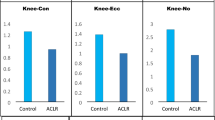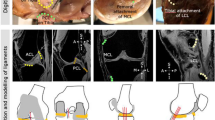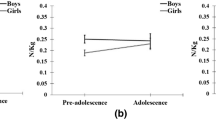Abstract
Purpose
Female athletes experience anterior cruciate ligament (ACL) injuries at a much greater rate than males, yet the mechanisms responsible for this are not well-understood. The current investigation aimed using a musculoskeletal simulation-based approach, to examine sex differences in ACL loading parameters during cut and hop movements.
Methods
Fifteen male and fifteen female participants completed 45° cut and maximal one legged hop movements. Three-dimensional motion capture and ground reaction force data during the stance phase of the cut movement and landing phase of the one legged hop were obtained. Lower extremity muscle forces, ACL forces and ACL strains were extracted via a simulation-based approach using a musculoskeletal model, with an ACL insertion into the femur and tibia.
Results
During the hop movement, females were associated with significantly greater peak ACL forces (male = 15.01 N/kg and female = 15.70 N/kg) and strains (male = 6.87% and female = 10.74%). In addition, for both the cut (male = 4.45 and female = 1.45) and hop (male = 2.04 and female = 1.46) movements, the soleus/gastrocnemius ratio was significantly larger in males.
Conclusions
The current investigation provides new information regarding sex differences during athletic movements that provide further insight regarding the increased incidence of ACL injuries in females.
Similar content being viewed by others
References
Adouni M, Shirazi-Adl A, Marouane H (2016) Role of gastrocnemius activation in knee joint biomechanics: gastrocnemius acts as an ACL antagonist. Comput Methods Biomech Biomed Eng 19:376–385
Ajuied A, Wong F, Smith C, Norris M, Earnshaw P, Back D, Davies A (2014) Anterior cruciate ligament injury and radiologic progression of knee osteoarthritis: a systematic review and meta-analysis. Am J Sports Med 42:2242–2252
Arendt EA, Agel J, Dick R (1999) Anterior cruciate ligament injury patterns among collegiate men and women. J Athl Train 34:86–92
Baratta R, Solomonow M, Zhou BH, Letson D, Chuinard R, D’Ambrosia R (1988) Muscle coactivation: the role of the antagonist musculature in maintaining knee stability. Am J Sports Med 16:113–122
Barker LA, Harry JR, Mercer JA (2018) Relationships between countermovement jump ground reaction forces and jump height, reactive strength index, and jump time. J Strength Cond Res 32:248–254
Benoit DL, Ramsey DK, Lamontagne M, Xu L, Wretenberg P, Renström P (2005) 22.4 Effect of skin movement artifact on knee kinematics during gait and cutting motions measured in-vivo. Gait Posture 24:152–164
Boden BP, Torg JS, Knowles SB, Hewett TE (2009) Video analysis of anterior cruciate ligament injury: abnormalities in hip and ankle kinematics. Am J Sports Med 37:252–259
Boden BP, Sheehan FT, Torg JS, Hewett TE (2010) Non-contact ACL injuries: mechanisms and risk factors. J Am Acad Orthop Surg 18:520–527
Caraffa A, Cerulli G, Projetti M, Aisa G, Rizzo A (1996) Prevention of anterior cruciate ligament injuries in soccer. Knee Surg Sports Traumatol Arthrosc 4:19–21
Chappell JD, Yu B, Kirkendall DT, Garrett WE (2002) A comparison of knee kinetics between male and female recreational athletes in stop-jump tasks. Am J Sports Med 30:261–267
Dai B, Mao D, Garrett WE, Yu B (2014) Anterior cruciate ligament injuries in soccer: loading mechanisms, risk factors, and prevention programs. J Sport Health Sci 3:299–306
Dargel J, Gotter M, Mader K, Pennig D, Koebke J, Schmidt-Wiethoff R (2007) Biomechanics of the anterior cruciate ligament and implications for surgical reconstruction. Strateg Trauma Limb Reconstr 2:1–12
Decker MJ, Torry MR, Wyland DJ, Sterett WI, Steadman JR (2003) Gender differences in lower extremity kinematics, kinetics and energy absorption during landing. Clin Biomech 18:662–669
Delp SL, Anderson FC, Arnold AS, Loan P, Habib A, John CT, Thelen DG (2007) OpenSim: open-source software to create and analyze dynamic simulations of movement. IEEE Trans Biomed Eng 54:1940–1950
Di Stasi S, Myer GD, Hewett TE (2013) Neuromuscular training to target deficits associated with second anterior cruciate ligament injury. J Orthop Sports Phys Ther 43:777–792
Draganich LF, Vahey JW (1990) An in vitro study of anterior cruciate ligament strain induced by quadriceps and hamstring forces. J Orthop Res 8:57–63
Dürselen L, Claes L, Kiefer H (1995) The influence of muscle forces and external loads on cruciate ligament strain. Am J Sports Med 23:129–136
Ebben WP, Fauth ML, Petushek EJ, Garceau LR, Hsu BE, Lutsch BN, Feldmann CR (2010) Gender-based analysis of hamstring and quadriceps muscle activation during jump landings and cutting. J Strength Cond Res 24:408–415
Ebstrup JF, Bojsen-Møller F (2000) Anterior cruciate ligament injury in indoor ball games. Scand J Med Sci Sports 10(2):114–116
Ellison AE, Berg EE (1985) Embryology, anatomy, and function of the anterior cruciate ligament. Orthop Clin N Am 16:3–14
Evans S, Shaginaw J, Bartolozzi A (2014) ACL reconstruction it’s all about timing. Int J Sports Phys Ther 9:268–273
Finch C, Owen N, Price R (2001) Current injury or disability as a barrier to being more physically active. Med Sci Sports Exerc 33:778–782
Fleming BC, Beynnon BD (2004) In vivo measurement of ligament/tendon strains and forces: a review. Ann Biomed Eng 32:318–328
Ford KR. Myer GD, Hewett TE (2003) Valgus knee motion during landing in high school female and male basketball players. Med Sci Sports Exerc 35:1745–1750
Gottlob CA, Baker CL, Pellissier JM, Colvin L (1999) Cost effectiveness of anterior cruciate ligament reconstruction in young adults. Clin Orthop Relat Res 367:272–282
Hewett TE, Stroupe AL, Nance TA, Noyes FR (1996) Plyometric training in female athletes: decreased impact forces and increased hamstring torques. Am J Sports Med 24:765–773
Hewett TE, Lindenfeld TN, Riccobene JV, Noyes FR (1999) The effect of neuromuscular training on the incidence of knee injury in female athletes. A prospective study. Am J Sports Med 27:699–706
Hewett TE, Myer GD, Ford KR, Heidt RS Jr, Colosimo AJ, McLean SG, Van den Bogert AJ, Paterno MV, Succop P (2005) Biomechanical measures of neuromuscular control and valgus loading of the knee predict anterior cruciate ligament injury risk in female athletes: a prospective study. Am J Sports Med 33:492–501
Huston LJ, Wojtys EM (1996) Neuromuscular performance characteristics in elite female athletes. Am J Sports Med 24:427–436
John R, Dhillon MS, Syam K, Prabhakar S, Behera P, Singh H (2016) Epidemiological profile of sports-related knee injuries in northern India: an observational study at a tertiary care centre. J Clin Orthop Trauma 7:207–211
Kaeding CC, Pedroza AD, Reinke EK, Huston LJ, Spindler KP (2015) Risk factors and predictors of subsequent ACL injury in either knee after ACL reconstruction: prospective analysis of 2488 primary ACL reconstructions from the MOON cohort. Am J Sports Med 43:1583–1590
Kar J, Quesada PM (2013) A musculoskeletal modeling approach for estimating anterior cruciate ligament strains and knee anterior–posterior shear forces in stop-jumps performed by young recreational female athletes. Ann Biomed Eng 41:338–348
Kernozek TW, Torry MR, Van Hoof H, Cowley H, Tanner S (2005) Gender differences in frontal and sagittal plane biomechanics during drop landings. Med Sci Sports Exerc 37:1003–1012
Kiriyama S, Sato H, Takahira N (2009) Gender differences in rotation of the shank during single-legged drop landing and its relation to rotational muscle strength of the knee. Am J Sports Med 37:168–174
Koga H, Nakamae A, Shima Y, Iwasa J, Myklebust G, Engebretsen L, Krosshaug T (2010) Mechanisms for noncontact anterior cruciate ligament injuries: knee joint kinematics in 10 injury situations from female team handball and basketball. Am J Sports Med 38:2218–2225
Koga H, Bahr R, Myklebust G, Engebretsen L, Grund T, Krosshaug T (2011) Estimating anterior tibial translation from model-based image-matching of a noncontact anterior cruciate ligament injury in professional football: a case report. Clin J Sport Med 21:271–274
Krosshaug T, Nakamae A, Boden BP, Engebretsen L, Smith G, Slauterbeck JR, Hewett TE, Bahr R (2007) Mechanisms of anterior cruciate ligament injury in basketball: video analysis of 39 cases. Am J Sports Med 35:359–367
LaBella CR, Huxford MR, Grissom J, Kim KY, Peng J, Christoffel KK (2011) Effect of neuromuscular warm-up on injuries in female soccer and basketball athletes in urban public high schools: cluster randomized controlled trial. Arch Pediatr Adolesc Med 165:1033–1040
Landry SC, McKean KA, Hubley-Kozey CL, Stanish WD, Deluzio KJ (2007) Neuromuscular and lower limb biomechanical differences exist between male and female elite adolescent soccer players during an unanticipated side-cut maneuver. Am J Sports Med 35:1888–1900
Lephart SM, Ferris CM, Riemann BL, Myers JB, Fu FH (2002) Gender differences in strength and lower extremity kinematics during landing. Clin Orthop Relat Res 401:162–169
Lerner ZF, Board WJ, Browning RC (2016) Pediatric obesity and walking duration increase medial tibiofemoral compartment contact forces. J Orthop Res 34:97–105
Li G, Rudy TW, Sakane M, Kanamori A, Ma CB, Woo SY (1999) The importance of quadriceps and hamstring muscle loading on knee kinematics and in-situ forces in the ACL. J Biomech 32:395–400
Lin CF, Liu H, Gros MT, Weinhold P, Garrett WE, Yu B (2012) Biomechanical risk factors of non-contact ACL injuries: a stochastic biomechanical modeling study. J Sport Health Sci 1:36–42
Lund K, Hicks J (2013) Getting started with RRA. https://simtk-confluence.stanford.edu:8443/display/OpenSim/Getting+Started+with+RRA. Accessed 10 Oct 2018
Malinzak RA, Colby SM, Kirkendall DT, Yu B, Garrett WE (2001) A comparison of knee joint motion patterns between men and women in selected athletic tasks. Clin Biomech 16:438–445
Mandelbaum BR, Silvers HJ, Watanabe DS (2005) Effectiveness of a neuromuscular and proprioceptive training program in preventing anterior cruciate ligament injuries in female athletes: 2-year follow-up. Am J Sports Med 33:1003–1010
Markolf KL, Burchfield DM, Shapiro MM, Shepard MF, Finerman GA, Slauterbeck JL (1995) Combined knee loading states that generate high anterior cruciate ligament forces. J Orthop Res 13:930–935
Markolf KL, O’Neil G, Jackson SR, McAllister DR (2004) Effects of applied quadriceps and hamstrings muscle loads on forces in the anterior and posterior cruciate ligaments. Am J Sports Med 32:1144–1149
Mather RC, Koenig L, Kocher MS, Dall TM, Gallo P, Scott DJ (2013) Societal and economic impact of anterior cruciate ligament tears. J Bone Jt Surg 95:1751–1759
Mokhtarzadeh H, Yeow CH, Goh JCH, Oetomo D, Malekipour F, Lee PVS (2013) Contributions of the soleus and gastrocnemius muscles to the anterior cruciate ligament loading during single-leg landing. J Biomech 46:1913–1920
Myklebust G, Engebretsen L, Braekken IH (2003) Prevention of anterior cruciate ligament injuries in female team handball players: a prospective intervention study over 3 seasons. Clin J Sport Med 13:71–78
Nagano Y, Ida H, Akai M, Fukubayashi T (2007) Gender differences in knee kinematics and muscle activity during single limb drop landings. Knee 14:218–223
Øiestad BE, Engebretsen L, Storheim K, Risberg MA (2009) Knee osteoarthritis after anterior cruciate ligament injury a systematic review. Am J Sports Med 37:1434–1443
Olsen OE, Myklebust G, Engebretsen L, Bahr R (2004) Injury mechanisms for anterior cruciate ligament injuries in team handball: a systematic video analysis. Am J Sports Med 32:1002–1012
Quatman CE, Hewett TE (2009) The ACL injury controversy: is “valgus collapse” a sex-specific mechanism? Br J Sport Med 43:328–335
Ruan M, Zhang Q, Wu X (2017) Acute effects of static stretching of hamstring on performance and anterior cruciate ligament injury risk during stop-jump and cutting tasks in female athletes. J Strength Cond Res 31:1241–1250
Russell KA, Palmieri RM, Zinder SM, Ingersoll CD (2006) Sex differences in valgus knee angle during a single-leg drop jump. J Athl Train 41:166–171
Schilaty ND, Bates NA, Nagelli CV, Krych AJ, Hewett TE (2018) Sex-based differences of medial collateral ligament and anterior cruciate ligament strains with cadaveric impact simulations. Orthop J Sports Med 6:2325967118765215
Shelbourne K, Nitz P (1992) Accelerated rehabilitation after anterior cruciate ligament reconstruction. J Orthop Sports Phys Ther 15:256–264
Shimokochi Y, Shultz SJ (2008) Mechanisms of noncontact anterior cruciate ligament injury. J Athl Train 43:396–408
Sinclair J, Greenhalgh A, Edmundson CJ, Brooks D, Hobbs SJ (2012) Gender differences in the kinetics and kinematics of distance running: implications for footwear design. Int J Sport Sci Eng 6:118–128
Smith HC, Vacek P, Johnson RJ, Slauterbeck JR, Hashemi J, Shultz S, Beynnon BD (2012) Risk factors for anterior cruciate ligament injury: a review of the literature—part 1: neuromuscular and anatomic risk. Sport Health 4:69–78
Solomonow M, Baratta R, Zhou BH, Shoji H, Bose W, Beck C, D’ambrosia R (1987) The synergistic action of the anterior cruciate ligament and thigh muscles in maintaining joint stability. Am J Sports Med 15:207–213
Taylor K, Cutcliffe HC, Queen RM, Utturkar GM, Spritzer CE, Garrett WE, DeFrate LE (2013) In vivo measurement of ACL length and relative strain during walking. J Biomech 46:478–483
Viskontas DG, Giuffre BM, Duggal N, Graham D, Parker D, Coolican M (2008) Bone bruises associated with ACL rupture: correlation with injury mechanism. Am J Sports Med 36:927–933
Voskanian N (2013) ACL Injury prevention in female athletes: review of the literature and practical considerations in implementing an ACL prevention program. Curr Rev Musculoskelet Med 6:158–163
Warburton DE, Nicol CW, Bredin SS (2006) Health benefits of physical activity: the evidence. Can Med Assoc J 174:801–809
Wascher DC, Markolf KL, Shapiro MS, Finerman GA (1993) Direct in vitro measurement of forces in the cruciate ligaments. Part I: the effect of multiplane loading in the intact knee. J Bone Jt Surg Am 75:377–386
Yu B, Garrett WE (2007) Mechanisms of non-contact ACL injuries. Br J Sport Med 41:47–51
Zajac FE, Neptune RR, Kautz SA (2002) Biomechanics and muscle coordination of human walking: part I: introduction to concepts, power transfer, dynamics and simulations. Gait Posture 16:215–232
Author information
Authors and Affiliations
Contributions
JS conceived and designed the study, collected the data, analysed the data, wrote and drafted the paper. DB conceived and designed the study, drafted the paper. PS collected the data, wrote and drafted the paper.
Corresponding author
Additional information
Communicated by Olivier Seynnes.
Publisher’s Note
Springer Nature remains neutral with regard to jurisdictional claims in published maps and institutional affiliations.
Rights and permissions
About this article
Cite this article
Sinclair, J., Brooks, D. & Stainton, P. Sex differences in ACL loading and strain during typical athletic movements: a musculoskeletal simulation analysis. Eur J Appl Physiol 119, 713–721 (2019). https://doi.org/10.1007/s00421-018-04062-w
Received:
Accepted:
Published:
Issue Date:
DOI: https://doi.org/10.1007/s00421-018-04062-w




